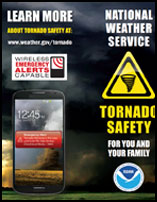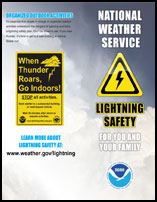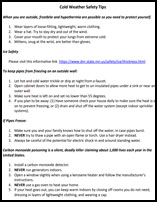Keep Safe
If you live in or near Eldridge, you know how fast the weather can change. Being educated and prepared for severe weather is your best best to surviving nature's worst storms and events. While tornadoes are top of the list, you also need to know about other weather occurrences like lightening, snow, wind and more. We have complied a list of information and down-loadable lists to help you prepare for the worst. (down-loadable Information at Bottom of Page)
Tornado
A tornado is a violently rotating column of air extending from the base of a thunderstorm down to the ground. Tornadoes are capable of completely destroying well-made structures, uprooting trees, and hurling objects through the air like deadly missiles. Tornadoes can occur at any time of day or night and at any time of the year. Although tornadoes are most common in the Central Plains and the southeastern United States, they have been reported in all 50 states.
What is the difference between a Tornado Watch and a Tornado Warning issued by the National Weather Service?
Tornado Watch:
Be Prepared! Tornadoes are possible in and near the watch area. Review and discuss your emergency plans and check supplies and your safe room. Be ready to act quickly if a warning is issued or you suspect a tornado is approaching. Acting early helps to save lives! Watches are issued by the Storm Prediction Center for counties where tornadoes may occur. The watch area is typically large, covering numerous counties or even states.
Tornado Warning:
Take Action! A tornado has been sighted or indicated by weather radar. There is imminent danger to life and property. Move to an interior room on the lowest floor of a sturdy building. Avoid windows. If in a mobile home, a vehicle, or outdoors, move to the closest substantial shelter and protect yourself from flying debris. Warnings are issued by your local forecast office. Warnings typically encompass a much smaller area (around the size of a city or small county) that may be impacted by a tornado identified by a forecaster on radar or by a trained spotter/law enforcement who is watching the storm.
Prepare?
- Be Weather-Ready: Check the forecast regularly to see if you're at risk for tornadoes. Listen to local news or a NOAA Weather Radio to stay informed about tornado watches and warnings.
- Create a Communications Plan: Have a family plan that includes an emergency meeting place and related information. If you live in a mobile home or home without a basement, identify a nearby safe building you can get too quickly, such as a church or family member.
- Pick a safe room in your home, such as a basement, storm cellar, or an interior room on the lowest floor with no windows.
- Practice Your Plan: Conduct a family severe thunderstorm drill regularly so everyone knows what to do if a tornado is approaching. Make sure all members of your family know to go there when tornado warnings are issued. Don't forget pets if time allows.
- Prepare Your Home: Consider having your safe room reinforced. You can find plans for reinforcing an interior room to provide better protection on the Federal Emergency Management Agency website.
- Help Your Neighbor: Encourage your loved ones to prepare for the possibility of tornadoes. Take CPR training so you can help if someone is hurt.
During A Tornado?
- Stay Weather-Ready: Continue to listen to local news or a NOAA Weather Radio to stay updated about tornado watches and warnings.
- At Your House: If you are in a tornado warning, go to your basement, safe room, or an interior room away from windows. Don't forget pets if time allows.
- At Your Workplace or School: Follow your tornado drill and proceed to your tornado shelter location quickly and calmly. Stay away from windows and do not go to large open rooms such as cafeterias, gymnasiums, or auditoriums.
- Outside: Seek shelter inside a sturdy building immediately if a tornado is approaching. Sheds and storage facilities are not safe. Neither is a mobile home or tent. If you have time, get to a safe building.
- In a vehicle: Being in a vehicle during a tornado is not safe. The best course of action is to drive to the closest shelter. If you are unable to make it to a safe shelter, either get down in your car and cover your head, or abandon your car and seek shelter in a low lying area such as a ditch or ravine.
Lightening Safety
Lightning: What You Need to Know
- NO PLACE outside is safe when thunderstorms are in the area!!
- If you hear thunder, lightning is close enough to strike you.
- When you hear thunder, immediately move to safe shelter: a substantial building with electricity or plumbing or an enclosed, metal-topped vehicle with windows up.
- Stay in safe shelter at least 30 minutes after you hear the last sound of thunder.
Indoor Lightning Safety
- Stay off corded phones, computers and other electrical equipment that put you in direct contact with electricity.
- Avoid plumbing, including sinks, baths and faucets.
- Stay away from windows and doors, and stay off porches.
- Do not lie on concrete floors, and do not lean against concrete walls.
Last Resort Outdoor Risk Reduction Tips
If you are caught outside with no safe shelter anywhere nearby the following actions may reduce your risk:
- Immediately get off elevated areas such as hills, mountain ridges or peaks
- Never lie flat on the ground
- Never shelter under an isolated tree
- Never use a cliff or rocky overhang for shelter
- Immediately get out and away from ponds, lakes and other bodies of water
- Stay away from objects that conduct electricity (barbed wire fences, power lines, windmills, etc.)
Winter Weather Safety
(Courtesy Nationwide Insurance)
Prepare yourself
- Stay indoors during the storm.
- Walk carefully on snowy, icy walkways.
- Avoid overexertion when shoveling snow. It’s a serious workout, and going at it too hard can bring on a heart attack − a major cause of death in the winter. If you must shovel snow, stretch before going outside.
- Stay dry. Wet clothing loses all of its insulating value and transmits the cold rapidly.
Cold-related injuries
- Watch for signs of frostbite: loss of feeling and white or pale appearance in extremities. If any of these occur, get medical help immediately.
- Watch for signs of hypothermia: uncontrollable shivering, memory loss, disorientation, incoherence, slurred speech, drowsiness and apparent exhaustion.
- If any of the hypothermia symptoms appear, get yourself (or the victim) to a warm location, remove wet clothing, and warm the center of the body first. Give the patient warm, non-alcoholic beverages if they are conscious. And of course, get medical help as soon as possible.
Prepare your home
- Clean out the gutters, disconnect and drain all outside hoses. If possible, shut off outside water valves.
- Insulate walls and attics, and caulk and weather-strip doors and windows.
- Repair roof leaks and remove tree branches that could get weighed down with ice or snow and fall on your house – or your neighbor's. (Avoid liability for the latter.)
- Wrap water pipes in your basement or crawl spaces with insulation sleeves to slow heat transfer.
- Consider an insulated blanket for your hot water heater.
- If you have a fireplace, keep the flue closed when you're not using it.
- Have a contractor check your roof to see if it would sustain the weight of a heavy snowfall.
- Make sure your furniture isn't blocking your home’s heating vents.
- During cold spells, keep cabinet doors open to allow warm air to circulate around pipes, particularly those in the kitchen and bathrooms.
- Keep a slow trickle of water flowing through faucets connected to pipes that run through unheated or unprotected spaces.
- If your house will be unattended during cold periods, consider draining the water system.
Prepare your car
According to the Department of Transportation, 22% of all vehicle crashes in the U.S. – and 16% of the fatalities – are due to severe weather such as rain, snow, sleet and ice.1 So, prepare your car for treacherous conditions and extremely cold temperatures – and know what to do if you find yourself stranded in a vehicle. When the temperatures start to drop:
- Drive only if it is absolutely necessary. If you must drive, travel during the day.
- Don’t travel alone. Keep others informed of your schedule.
- Stay on main roads and avoid back road shortcuts.
- Top off antifreeze, windshield wiper fluid, gas, oil and other fluids.
- Make sure your tires have enough tread. Consider snow tires.
- Keep bagged salt or sand in the trunk for extra traction and to melt ice.
- Clear snow from the top of the car, headlights and windows.
- Save the numbers for your auto club, insurance agent and towing service into your cell phone.
- Keep a cold-weather kit in your trunk. It should include a blanket or sleeping bag, gloves, hard candy, bottled water, folding shovel, first aid kit, flashlight and cell phone charger.
If you’re trapped in a vehicle
- Remain inside. Rescuers are more likely to find you there.
- Run the engine and heater about 10 minutes every hour. Clear any snow from the exhaust pipe to reduce your risk of carbon monoxide poisoning.
- Move around to maintain heat.
- Use maps, floor mats and seat covers for insulation.
- Take turns sleeping. Someone should always be awake to alert rescuers.
- Drink fluids to avoid dehydration.
- Turn on the inside light at night so rescue crews can find you.
- If you’re stranded in a remote area, stomp out the words "SOS" or "HELP" in the snow.
Downloads & Checklists


